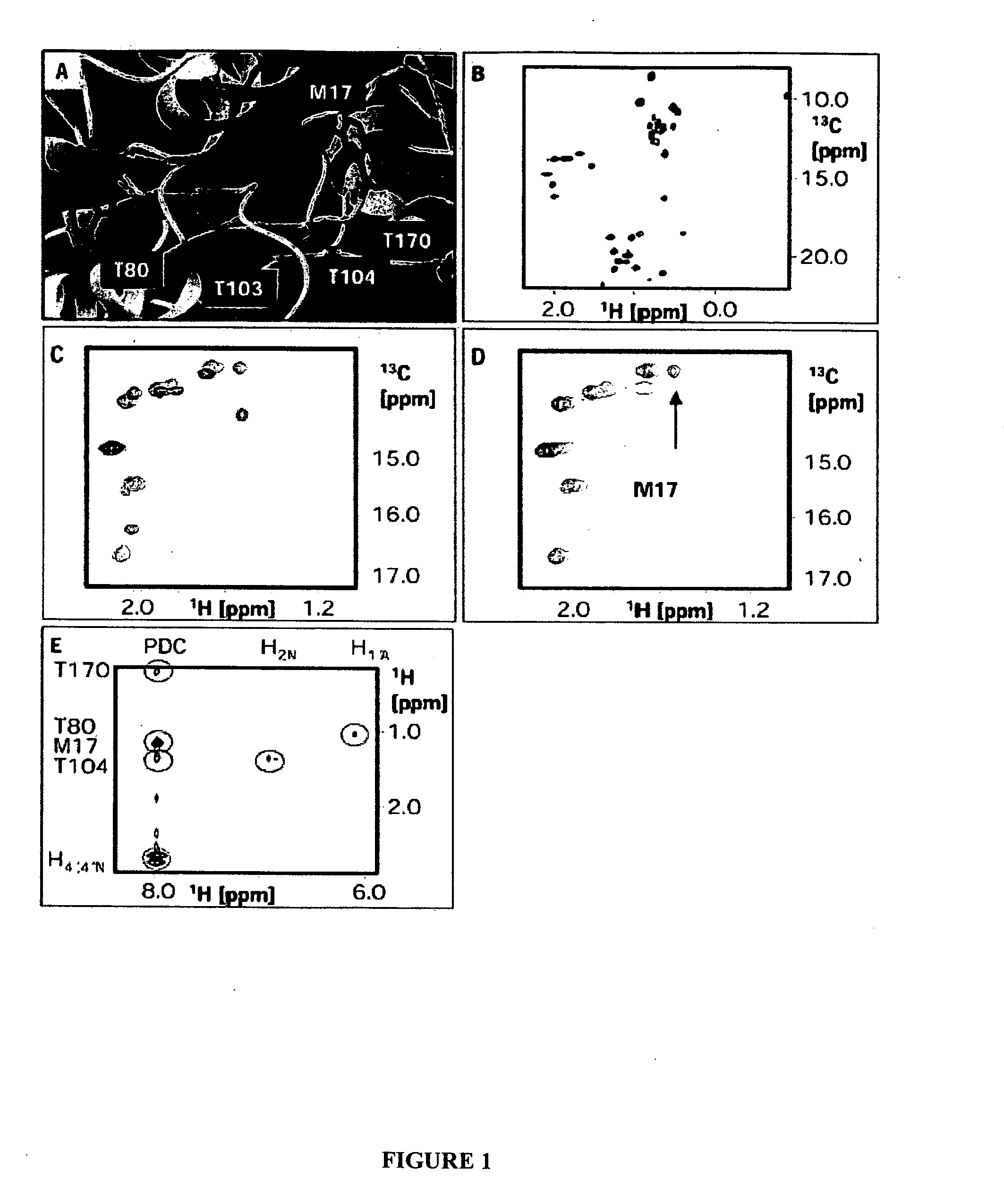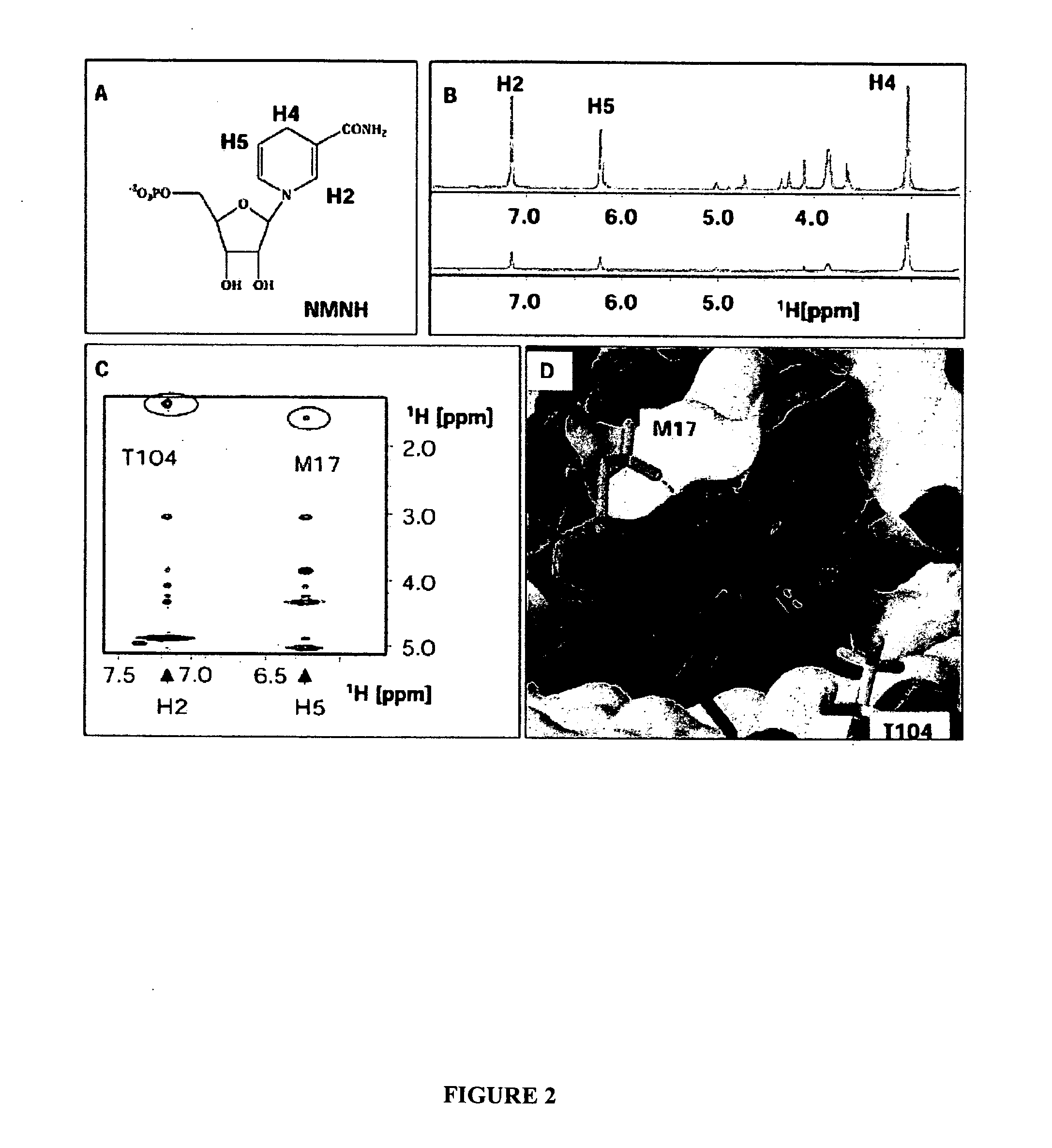Nuclear magnetic resonance-docking of compounds
- Summary
- Abstract
- Description
- Claims
- Application Information
AI Technical Summary
Benefits of technology
Problems solved by technology
Method used
Image
Examples
example i
Docking of a Furoic Acid-Based Inhibitor into the Binding Site of DHPR
[0126] This Example demonstrates determination of a three dimensional model of a furoic acid-based inhibitor bound to the NADH binding site of E. coli Dihydrodipicolinate reductase (DHPR). In particular, this example describes, expression and purification of isotopically labeled DHPR; NMR measurements of a DHPR-NADH complex to assign DHPR binding site residues that interact with NADH; NOE measurements of a DHPR-inhibitor complex to determine distances between the binding site residues and the inhibitor; and docking of the inhibitor to a previously determined structure model of DHPR based on distance constraints derived from the NOE measurements.
A. Expression of Isotopically Labeled DHPR
[0127]E. coli DHPR was selectively labeled with 13Cε / 1H Met, 13Cδ / 1H Ile and 13C / 1H Thr and uniformly labeled with 2H. The resulting labeled protein is referred to as MIT-DHPR. This labeling scheme was chosen based on analysis o...
example ii
Overlay of a Furoic Acid-Based Inhibitor onto DHPR-Bound NADH
[0146] This Example describes determination of a three dimensional model of a furoic acid-based inhibitor (TTM2000—29—85) by comparison to the structure of NADH when bound to E. coli Dihydrodipicolinate reductase (DHPR). In particular, this example describes comparing cross-peaks for a 2D NOESY spectrum of a DHPR-NADH complex with cross-peaks for a 2D NOESY spectra of a DHPR-TTM2000—29—85 complex and overlaying a structure model of TTM2000—29—85 and NADH based on distance constraints derived from the NOE measurements. As described below, neither assignment of DHPR-derived peaks to particular binding site residues nor a structural model of DHPR is necessary to determine structural properties of the inhibitor by ligand overlay.
[0147] DHPR is expressed, isotopically labeled and purified and NMR measurements are obtained as described in Example 1.
[0148] Binding site cross-peaks are identified from NOESY spectra for the tern...
example iii
Validation of a Binding Site Homology Model for 1-Deoxy-D-Xylulose-5-Phosphate Reductoisomerase
[0151] This example demonstrates generation of a homology model for 1-Deoxy-D-xylulose 5-phosphate reductoisomerase (DOXPR) based on sequence analysis. Validation of the model using nuclear magnetic resonance spectroscopy is also demonstrated.
[0152] 1-Deoxy-D-xylulose 5-phosphate reductoisomerase (DOXPR) is an enzyme involved in isoprenoid biosynthesis, catalyzing the formation of 2-C-methyl-D-erythritol from 1-deoxy-D-xylulose 5-phosphate (Takahashi et al., Proc. Natl. Acad. Sci. USA 95:9879-9884 (1998)). The deoxyxylulose pathway, found in some bacteria, algae, plants and protozoa, is an alternate to the ubiquitous mevalonate pathway for isoprenoid biosynthesis (Eisenreich et al., Trends Plant Sci. 6:78-84 (2001)). Because a three dimensional model of the DOXPR structure was not available and to aid in the design of inhibitors of DOXPR, a model for the NADPH-binding, N-terminal domain ...
PUM
 Login to View More
Login to View More Abstract
Description
Claims
Application Information
 Login to View More
Login to View More - R&D
- Intellectual Property
- Life Sciences
- Materials
- Tech Scout
- Unparalleled Data Quality
- Higher Quality Content
- 60% Fewer Hallucinations
Browse by: Latest US Patents, China's latest patents, Technical Efficacy Thesaurus, Application Domain, Technology Topic, Popular Technical Reports.
© 2025 PatSnap. All rights reserved.Legal|Privacy policy|Modern Slavery Act Transparency Statement|Sitemap|About US| Contact US: help@patsnap.com



